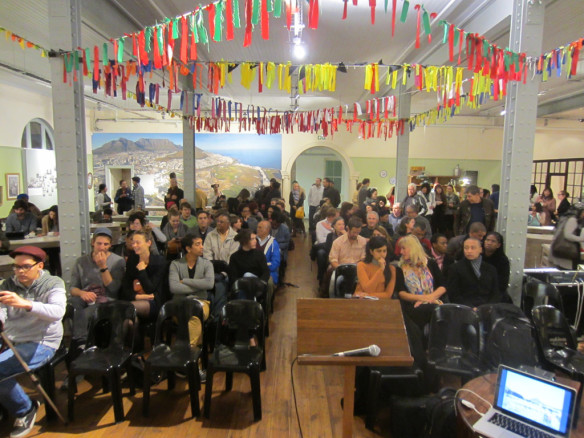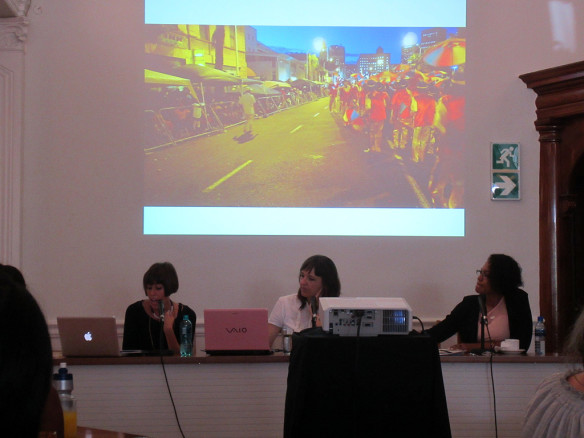
The District Six Homecoming Centre, while we were still setting up. By the time we started it was standing room only – thanks everyone who attended!
The PublicCulture CityLab at the African Centre for Cities hosted a public event last Wednesday night with the District Six Museum, titled ‘District Six on the Fringe: The absence of memory in design-led urban regeneration‘. A series of presentations, followed by Q + A with the audience, looked at issues around the development of the East City as the ‘The Fringe Innovation District‘. My colleague at the ACC, Ismail Farouk, and the District Six Museum delivered the keynote addresses, and I chaired the event. Opening presentations were made by the artist Andrew Putter and visiting Cologne International School of Design student Kai Berthold.
From our invitation to the event:
The area designated as ‘The Fringe’ is intertwined with District Six and yet that history of the space, with its memory of forced removals, has not figured significantly in the ‘cultural regeneration’ plans for the East City. What place is there for memory and history within culture-led urban development? What risk is there that contemporary stylizations of Cape Town might serve to obliterate local histories and entrench the status quo? What of District Six, not only as symbol and museum, but as marker of the pasts that haunt the present?
The event was informed in part by a public document authored by the District Six Museum as a critique of the Fringe Innovation District draft framework, which they spoke to on the night, and you can download here: The Fringe: Draft Framework – District Six Museum comments 4 March 2013. The text of Ismail Farouk’s presentation can be downloaded here: Conflicting rationalities – Post-apartheid spatial legacies and the Creative City.
This is the full programme of speakers and presentations on the night:
Kai Berthold Exploring gentrification in cities around the world
Kai Berthold is a visiting student from Koln International School of Design (KISD) in Germany. He is part of a project called The Gentrification Relay that worked with Cape Town students to investigate and address issues around gentrification and the East City.
Andrew Putter Harrington Square for the neighbourhood
The artist Andrew Putter is working for the Cape Town Partnership to facilitate the public involvement in the unfolding of Harrington Square as a public place.
Bonita Bennett District Six Museum Statement: Erasure of memory in the remaking of the East City
The District Six Museum as a cultural institution promotes innovative curatorial practices in addressing issues of memory and dislocation. In considering the place-making strategies for developing the East City, what place is there for understanding the politics of erasure?
Ismail Farouk Conflicting rationalities: Post-apartheid spatial legacies and the Creative City
Ismail Farouk presents some of the results of his long-term investigation into understanding the precinct development in the East City. His work explores the tensions and challenges in redressing historical inequalities in Cape Town through ‘design’.
(UPDATE 17/6/2013 – an article about the event on Africa is a Country)

